Tube Sockets
Tube sockets were ubiquitous in early electronic equipment to allow vacuum tubes (also known as valves) to be easily removed for testing and replacement. Tubes often failed because the filament burned out, but other failure modes were common. more...
In the heyday of radio and early television, it was common to find a vacuum tube tester in local drug stores, which also sold replacement tubes.
Tube sockets were typically mounted in holes on a sheet metal chassis and wires or other components were hand soldered to lugs on the underside of the socket. In the 1950s printed circuit boards were introduced and tube sockets were developed whose contacts could be soldered directly to the printed wiring traces. Looking at the bottom of a socket, or, equivalently, a tube from its bottom, the pins were numbered clockwise, starting at an index notch or gap, a convention that has persisted into the integrated circuit era.
In the 1930's tubes often had the connection to the control grid, brought out though a metal cap on the top of the tube. This was conected by using a clip with an attached wire lead. An example would be the 6A7 pentagrid converter. Later, some tubes particularly those used as radio frequency (RF) power amplifiers or horizontal delection amplifiers in TV sets such as the 6DQ6 had the plate or anode lead protrude through the envelope. In both cases this allowed the tube's output circuitry to be isolated from the input (grid) circuit more effectively. In the case of the tubes with the plate brought out to a cap, this also allowed the plate to run at higher voltages (over 26,000 volts in the case of rectifiers for colour television such as the 3A3).
Octal base
In 1935, RCA introduced a new type of tube base for their new metal envelope tubes, which they called an "Octal base". True to the name, it had 8 pins on an 11/16" pin circle, with a 5/16" diameter keyed locating prong or "spigot" in the center.When used on metal tubes, pin #1 was always reserved for a connection to the metal shell, which was grounded for shielding purposes.
The octal base soon caught on for conventional glass tubes as well, where the large central prong could also house and protect the "evacuation tip" of the glass tube. The eight available pins allowed more complex tubes to be constructed, including dual triodes, etc. The glass envelope of each octal vacuum tube (for example, the 6SN7) was cemented into a bakelite or plastic base with a hollow post in the center, surrounded by eight metal pins. The wire leads from the tube were soldered into the pins and the pinched-off glass nub through which the air was evacuated from the envelope fit into the post. The post had a protrusion along one side that matched the indexing slot in the socket so the tube could only be inserted in the correct orientation.
Matching plugs were manufactured that let tube sockets be used as electrical connectors, though penurious experimenters would salvage the base from a burned out tube for this purpose. Octal sockets were used to mount other components, particularly electrical relays and octal-mount relays are still common.
Read more at Wikipedia.org



